| MIATA BUILD |
|
|
 |  |  | March 4, 2008 - The moment of truth for the header.
Did all that work actually get me anything? In short, yes! I saw a gain of 15 lb-ft at 3500 rpm and around 10 hp at 5200 rpm. Cue the happy dance.
The car sure sounded different, as you could hear some strong resonances and beats coming from underhood. That's good, the header is all about resonant frequencies.
On the dyno run, you can see the Racing Beat header in blue and the new one in red. Other than a minor loss between 4000-4500 rpm, the new one is a winner right across the board. It didn't unplug the engine above 6000 rpm as I'd hoped, but a big slug of torque across the range is a lot more useful on the Targa.
Dyno chart
Now, the engine still isn't anywhere near its potential. Keep that in mind when looking at the dyno chart. I don't know if my 200 hp at the wheels goal is attainable, but 170 should be possible. The cams are under suspicion, as sister engines to this one have held power a bit longer without giving up the bottom end. I have another couple of options to try and there hasn't been any experimentation with the cam gears yet. Since they typically trade off low end for high end and vice versa, I don't think they're going to solve things overall. Still, it's worth trying.
Jeremy Ferber from Flyin' Miata was the tuning meister, working in temporary conditions as FM is in the middle of a move.
It wasn't all good news, though. It turns out the car has a problem with the wideband O2 sensor, so we couldn't do a whole lot with tuning. Normally, Jeremy has enough experience to tune via injector pulse width against horsepower, but the 2001 injectors I'm using aren't in his mental program. So I'll be doing a little diagnosis to sort that out - we suspect the heater circuit isn't working. The car was also running hotter than it should, so I'll take a look to make sure the thermostat is working properly.
entry 426 - tags: header, engine, dyno |  |  |  | March 4, 2008 - Despite the problems, we did get a chance for some comparative testing on the dyno.
My temporary intake pulled hot air from behind the radiator. That's one reason it was temporary, and why it was mounted upside down in the previous picture of the car on the dyno.
For interest's sake, we pulled out a stock 1994 intake tract that includes a resonating Heimholtz chamber. It's not perfectly sized for my engine - I believe the theory says it should be equivalent to 1.5 cylinders worth of displacement - but it was worth trying. And whaddya know, it did something! Nothing major, but 4 lb-ft at 4000 rpm for free is nothing to complain about. The red graph is the stock setup.
Dyno chart
Using the stock crossover tube will also let me put the filter in a cooler place than right behind the rad, which will reap benefits in the real world where having a filter sticking through the hood is awkward to arrange.
In the picture, you can see the filter from my original intake resting inside the engine bay. Don't be fooled, we don't have some sort of bizarre dual-filter setup going here.
entry 427 - tags: engine, dyno, intake |  |  | March 5, 2008 - As expected, some people have been focusing in on the peak horsepower of the engine and scoffing.
Sure, that's understandable. It would be an expensive engine to buy and it's not making the headline horsepower numbers that people expect to see. But it's also not finished development yet, and it's doing well in the range I need for the Targa. I'll get those headline numbers eventually, although the driver and suspension are more important at this point.
In the meantime, here's a comparison between a fully built CSP-legal 1.8 with 10.5:1 compression. It's a pretty nice engine and the car feels quick. Which of these would be faster on the road?
2.0 vs 1.8 dyno chart
entry 428 - tags: engine |  |  | 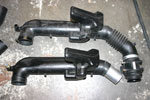 | March 6, 2008 - The stock intake needed to be modified to fit my car.
The biggest problem was the big loop in the #1 runner in the header. The stock setup basically drove directly into that. Not good. So, a little bit of trimming and a chunk of pipe later, and voila! The tube is made of hard rubber, so it fit around the pipe really nicely. A clamp ensures nothing comes free.
On the left side of the picture, you can see how my air temperature sensor fits in the bung originally used for the idle speed control valve intake on this 1994 part. On my 1999 throttle body, that intake is inside the throttle body so the fitting is unused. The air temperature sensor screwed right in there tightly as if it was meant to be installed in this location.
entry 429 - tags: intake, engine |  |  |  | March 6, 2008 - The intake in place.
Okay, that black plastic/rubber crossover tube isn't really very sexy. But it works, and that's what counts here.
There's a bracket supporting the crossover tube at the short piece of pipe, then another supporting the air filter. It's not an ideal spot for the filter, really, but I'll make a heat shield to protect it - and the brake lines - from the header heat before too long. That flexible hose isn't as tightly stretched as it appears in this picture, by the way.
Speaking of the header, note what happens when you forget to degrease the pipes before painting with high-temp paint. Whoops.
I also sorted out the wideband oxygen sensor problem. It appears to have been a bad heater in the sensor. I popped in another to check it out, and on a test drive I saw a good range of numbers. The old sensor would work fine until exhaust flow got high, then it would just sit at 14.7:1. The new one showed numbers as rich at 10:1 under wide open throttle. Obviously not good for power, but at least I know the sensor's working! I'll let the car autotune itself at the track this weekend. I don't think I'll have time to dyno the car tomorrow.
entry 430 - tags: intake, header, engine |  |  |  | March 10, 2008 - Time for another test.
After a long tow through some nasty weather (check out that filthy hood!), we made it to Pueblo for the most recent testing session. The goals for this one were primarily to work on the driver/navigator team, although as always suspension tuning was involved.
After a late start due to a car that was stuck on the track with the doors locked and the engine running (!), I took the car out solo in wet (and rapidly drying) conditions. The brakes didn't feel good. A nice solid pedal, yes. But I wasn't getting much feedback. This kept up over the whole day so I'm not sure what's going on or if it was just a matter of a lack of faith on my part. Since I was planning on making some big changes to the pads shortly, I'll look at them more closely later.
The car felt pretty good. The handling balance with the new alignment wasn't right on the first session, it was a bit too biased towards understeer as I'd expected. Not terrible and certainly stable, but I do generally prefer a car that's set up to be a bit on the loose side. The suspension was swallowing up just about everything. Just about?
The final turn has been reconfigured to make it much tighter than before. It will be repaved this summer, but for the time being it's rough. Really rough. There was a deep dip in the pavement right past the apex that was bottoming out the suspension hard. When I crawled under the car to do some sway bar adjustments, I noticed that the left rear spring had marks indicating it had hit coil bind. Ahh, that's not good. The fairly high ride height and the 8" springs were a bad combination. Since I didn't have any way to deal with it, I played with the corner to avoid that hole for the rest of the day. Elsewhere on the track, I was able to drive over berms - even the rough "dragon's teeth" ones - with impunity. So that was working well. Despite a slight understeer in fast sweepers, the car was both faithful and mobile when I was setting up for corners so it's probably a pretty safe setup for the Targa now. It was quick enough to let me pass a Lotus Elise without any difficulty, that's a good sign.
I'm going to try a couple of things to sort out that coil bind. There are a set of 10" springs on the way to replace my 8" ones, as they'll give an extra 1.25" of spring travel and that will avoid the binding. They're a 250 instead of my current 225 so I can make the rear slightly more mobile. I also ordered some 375 lb springs, thinking I could try a 375/300 combination instead of my current 300/225. The stiffer springs not only give an extra 0.5" of spring travel, they'll use a lower perch height for the same ride height so binding should not be a problem. Now, do I want the extra stiffness or do I keep the car fairly soft? I'll have both options available to me.
The header worked perfectly all day, not showing any signs of weakness or cracking. That's good.
entry 431 - tags: testing, suspension, header |  |  |  | March 10, 2008 - What about in the car?
Once I'd roused Janel from the comfort of a warm tow vehicle, we discovered that our concerns about nausea were unfounded. With the rally computer to play with, she was distracted and forgot to get sick. Excellent!
The intercom worked well, allowing me to hear her clearly. She couldn't hear me quite as well - probably because the speakers were further from her ears - but that's a good setup. I did discover how hard it is to concentrate on driving quickly while also carrying on a conversation about how the trip computer works. Once the communication became more one-way, I was able to work better on dealing with the inputs.
For one session, she brought along a book and read it to me. Seems like an odd test, but we didn't have pace notes for the track, you see. Again, no problems with nausea as long as she kept her legs braced and didn't let them flop around. So the track day was a good test then. We learned a few things, that was the goal.
Eric asked for a picture of the whole interior in the mostly-final configuration. Here you go!
entry 432 - tags: testing, skills, computer, intercom |  |  |  | March 10, 2008 - A very serious sticker.
I saw some spy shots of the Porsche Panamerica taken in South Africa. They had this sticker. I had to have one, so a friend duplicated it for me.
The track day wasn't all work on the race car. I got to drive the FM Westfield, now with 100% more turbocharger. Holy cow, it was a great ride. The chassis of the Westfield was easily able to deal with the horsepower, and it became a massively fast machine. It had a better power/weight ratio than the Atom I drove almost a year ago, while also having a much better gearshift and more exploitable handling. It's a beast.
Another car that I got to drive was a V8 powered MGB GT. It made a wonderful noise. It wasn't fast - there's still a lot of work to do on the car - but the combination of the shape in BRG and the rumble was compelling. There's an advantage to hanging out in the pits wearing a driver's suit and playing with an obvious race car - people ask you to drive their cars and want to know what you think!
entry 433 - tags: other cars |  |  | March 12, 2008 - Back on the dyno.
I took the long (loooong) way in to work this morning to make sure the wideband was working well. Other than a really slow warm-up time, it seemed to be. But when we strapped the car to the dyno, it was misbehaving by the third run. This is really frustrating. Time to do some more diagnosis - the guys at Hydra want me to try a different ECU.
I didn't do any cam testing as I'd hoped, so instead we basically just repeated what we'd done before - but we pulled out a bit of the excess fuel and put in a degree of timing. Nothing to make any difference to the curves.
Instead, I'll probably end up swapping cams at home, then using the autotune feature of the ECU to see if it wants to add fuel. Crude, but it'll give me a rough idea of what's happening. Then it'll go back on the dyno in a few weeks.
entry 434 - tags: engine, dyno |  |  | 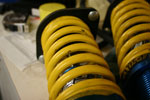 | March 13, 2008 - This is what coil bind looks like.
See the marks on the springs where the coils came together? Not good. What's interesting is that the right side is almost completely free of marks. The perch on that side was 8mm lower. That's the margin of error I was dealing with. Why did this happen? Because I put the wrong bumpstop for my ride height in the shocks. Whoops.
No worries, I have others. I also have those 10" springs coming. The big question is - do I try the 375/300 combination, or do I install the 300/250?
entry 435 - tags: suspension |  |  | March 13, 2008 - I've decided after the day at the track and some street driving that I really like having a Camelbak installed in the car with a handy drinking tube.
It's amazing how often I find myself taking a sip. On the front straight of the track, on the back roads, on the drive home from work. Highly recommended!
entry 436 - tags: ergonomics |  |  |  | March 16, 2008 - I was going to spend the weekend working on the car's suspension.
I have the new springs. However, AFCO wanted to take a look at the shocks so they're off getting checked out. This also prevents me from doing any more testing on the wideband.
Instead, I installed the first aid kit. This was provided to us by Susquehanna Motorsports, aka rallylights.com. It's mounted in the trunk, and I made this strap to hold it in place securely. There's also a piece of aluminum angle iron riveted in front to hold it in place. It's not going anywhere, but it's quick and easy to access. Perfect.
entry 437 - tags: safety, sponsors |  |  | March 21, 2008 - Big work on the car so far this week.
It's on jackstands, waiting for the shocks to come back after a final AFCO checkup. So I spent some time on it last night and wired up the horn. Big job! Actually, more complex than you might think because the steering wheel adapter I have on the car is from...well, I'm not sure what it's from. Definitely not a Miata. So the wiring doesn't fit. Thus I resorted to a coiled phone cord that can wind around the column as I twirl the wheel merrily. Hey, it needed to be done.
Beep!
entry 438 - tags: wiring |  |  | 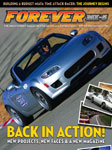 | March 21, 2008 - The Targa Miata is featured in the premiere edition of Forever MX-5 magazine!
It's an honor to have the car chosen as their first feature car, and I'm really happy with how the article came out. Heck, I'm like a proud father.
If you'd like to read the article, you can download it here as a 3.2 MB PDF file.
The magazine isn't available on newsstands, but you can subscribe at ForeverMX5.com or a copy of the issue at Carzines.com. They've actually asked me to be a regular columnist for the magazine, either due to my writing abilities or out of sheer desperation. You decide.
Here's why they chose it:
We chose Keith Tanner’s Targa Miata as our feature car for the first issue of Forever MX-5 because it embodies the very best of the Miata world. It’s a top-notch sports car, built for speed, handling, and all-around performance. And it’s a beautiful work of art, painted and polished with care and attention to detail. Finally, it’s a car built for a lively purpose — running flat out on the open road, having the time of your sweet life with your best friend by your side.
entry 439 - tags: announcements |  |  | March 26, 2008 - The shocks are back in the car.
I installed the 375/300 springs. They'll get their first test on Sunday at another Corvette autocross. Hopefully I'll get a chance to throw the car into a few hard corners first so I don't discover lots of oversteer by accident. I'll have some tools with me!
entry 440 - tags: suspension |  |  |  | March 30, 2008 - I need new brake pads.
Something more suited to the sort of use this car will see. I'm going to run the Performance Friction PFC97 on the front and Carbotech XP8s on the rear. This is a combination that has worked really well on some Flyin' Miata cars, giving very good braking when cold and exceptional braking when hot. The downside is that PFC97 destroys rotors when cold. No worries, they're easy to change out.
The fronts are on order. But for the rear, I had a set of XP8s in the 2001-05 brake size. I also had a set of Porterfield R4S pads in the 1994-02 size, which conforms to the calipers I have in the car. Brandon needed a set of R4S pads and had 2001-05 brackets in the rear of his car. Since my rear brackets are from a Flyin' Miata big brake kit and use the same size rotor, we decided to swap. Parts went flying everywhere, and when we were done we each had new rear brake pads in the size we wanted. It seems very complex in retrospect, but really it makes sense.
entry 441 - tags: brakes |  |  |  | March 30, 2008 - The Carbotech XP8 pads appear to have copper in them them.
Either that or gold. There are big flakes in the pad compound.
entry 442 - tags: brakes |  |  | 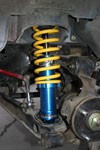 | March 30, 2008 - I have a few road miles on the 375/300 spring combination, and I really like how it's working.
It's a good balance between supple and responsive on the road. Very nice, I think this will be the final spring setup for the race.
entry 443 - tags: suspension |  |  | 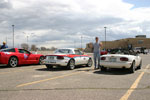 | March 30, 2008 - Autocross time!
The Corvette club was holding another autox, so I brought out the race car to see how the new suspension would sort out. Last time, I was hampered by the open differential but still posted a good time. Let's see how it works this time.
The lot was dusty and it was relatively cool, so it was a good test of the ability to put power down. Which turned out to be a challenge. Despite the Torsen diff, I was still getting wheelspin on the inside rear wheel exiting right turns. This is frustrating. It wasn't a problem on the track a few weeks back and it was only apparent on the tight confines of an autocross course, but still - I thought I had this licked. I'm going to do a little more poking around. Course workers confirm that the inside rear was simply unloaded and just spun up. A Torsen will go fully open when there's just no traction on one corner. I could throw in a preloaded Guru differential for the track day next weekend, or maybe I'll just let it stay as is so I can do a direct before/after comparison.
The first few runs showed that I had the ability to light up the rear tire(s) and slide the rear end around, but also that the car seemed to have some understeer in the few steady-state corners on the course. So I softened the front sway bar slightly to see if that sorted the problem. Yup, the car was much happier. It may be a little too biased towards oversteer now, but we'll find out next weekend on the kart track. Right now, it'll do exactly what I ask it to and can really be moved around on demand. Of course, that's with a maximum speed of 57 mph according to the rally computer. How will it do at 120?
I was also playing with the brake bias, thanks to the new pads. For a couple of runs, I had too much in the rear. The final braking zone took place in the middle of a big sweeper, so the car was unbalanced to begin with. On one run, I was countersteering fairly enthusiastically to keep the rear wheels behind me as the car wagged its tail into the corner. It worked, though, and a quick twist of the proportioning valve sorted that out. By the end of the day, I had the brakes dialed in pretty nicely and the car was mobile yet controllable under braking. Of course, I'll have to do it all over again once the new pads are installed.
So, how did it do? Well, there was an STi on sticky tires in attendance. Try as I might, I couldn't get within a half second of him. But Brandon and I were locked in a great battle. He has an extra 110 hp and Azenis tires, while I have the Toyo RA1s. It turned out to be an excellent match, going right down to the wire. The final margin was 0.079 seconds, with me being slightly faster. What a great race. I managed to come in second overall, which is not shabby at all. None of the Corvettes able to keep up with the three fiercely battling "metal cars". The fastest 'Vette was 1.8 seconds behind us.
Brandon, if you're going to strike a goofy pose for the picture, I'm going to take the picture!
entry 444 - tags: testing |  |  | 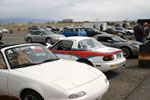 | April 5, 2008 - Another trackday test.
This was on our local kart track, the same track used for the car's first track day. I wanted to see how the suspension was doing, and see if the car could put power down.
Immediately it became apparent that the track was fast today. My existing lap record fell almost immediately to a turbo Westfield. That was set in the Seven, so I didn't have a chance to fight to get it back. My own times were quick as well though, as I ran times that were quicker than we've seen from Miatas here before. Recent rain has left the track much cleaner than usual, I suspect.
On track, the car felt great. The suspension is almost perfect, allowing me to take completely ridiculous lines through the chicane. I wasn't just putting the wheels on the berms, I was dropping off the other side and essentially straight-lining the course. I never bottomed out and the car wasn't upset at all. Only once did I scuff the bottom of the car, and to do that I had to put my outside wheels where most people ran their inside ones! We shot some video of the car from behind that shows my fairly ludicrous lines, I'll have that posted before too long. When I took my friend Mark (last seen welding the roll cage into the car a year ago) out for a ride, he was amazed. "It doesn't feel like a Miata, it feels like a rally car!". He was also impressed with the feeling of stability and adjustability in the car, as it just gripped and gripped and never seemed to get upset. The car and I are bonding, and it's become a very useful tool. Bill Cardell took a break from hammering on my lap record to take the car out for a run, and he was quite impressed with the setup as well. The new brakes with the Performance Friction front pads really worked nicely, hauling the car down remarkably fast with lots of stability. There are a couple of corners on this track that really test both braking and stability so it was a good venue.
Unfortunately, the car again showed an inability to lay down any power in a right turn. I started running with ballast (aka passengers) after the first session, and that seemed to help somewhat. But still, it's acting just as if there's an open diff back there. So either I got it wrong and installed an open (again!), there's something wrong with my Torsen (I can't think of how that would happen) or for some reason the suspension setup is unweighting that inside wheel. Given the amount of droop travel available, I doubt it's the latter. The car feels exactly like it did with the open diff back at the Open House testing, although I blamed a short-travel suspension for the behavior then. So step one is to confirm it's a Torsen for sure for sure. I'm also going to cornerweight the car and see if it's way off, but still. A turbo Miata running almost exactly the same tires (225/45-15 instead of 205/50-15) and an extra 130 hp was not having the same problem.
So how did I do? Well, I had the fastest Miata there at 1:04.989, running clockwise. That's 1.5 seconds faster than we've seen a Miata go around the track in that direction, I think. Running counterclockwise, I ran a 1:05.228. I even beat that turbo Miata on race tires. The only cars that went faster were the turbo Westfield and that STi from last weekend. No shame there! In the case of the turbo Miata, it was a matter of suspension versus horsepower again. That car's fitted with a JIC Magic suspension and is very competent on the track. It's just not quite as competent. That car was also being piloted by a very good driver who knows the track well, so it's fair to say that most of the difference was in the car.
entry 445 - tags: suspension, testing, brakes |  |  |
|

 THE DIARY
THE DIARY